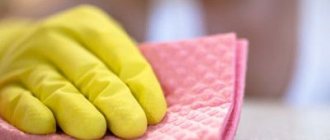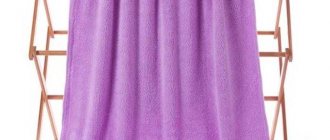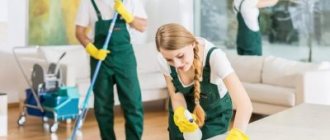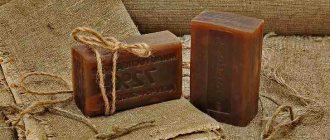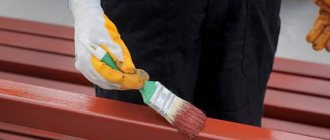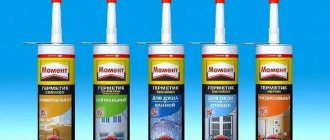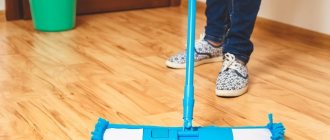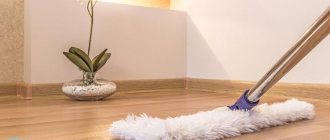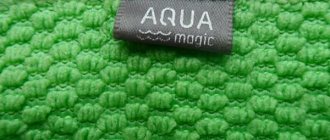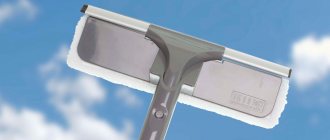Previously, rags for cleaning floors were made from old clothes. Now the store offers a huge selection of cleaning rags made from a variety of materials. They have different properties. The price also varies. When choosing the best floor cloth, you should take into account its characteristics and the characteristics of the room for which it is intended to be cleaned.
What is microfiber
A synthetic material consisting of two interwoven microfibers, polyester and polyamide, with split ends in the form of hooks. In all respects, this fabric is superior to cotton and viscose products.
Synthetic product
Professional cleaning companies use three types of rags for cleaning:
- natural, made of cotton and linen;
- artificial viscose;
- synthetic, made of polyamide and polyester.
All varieties have different properties of softness, strength, wear resistance and elasticity, and the ability to absorb water. Microscopic fibers, twisted in a special way, cope with cleaning any surfaces.
Microfiber
The household market offers napkins and rags for cleaning, pet care, optics and computer equipment, car washing and kitchen.
The popularity of the material was achieved thanks to:
- Penetrating effect when cleaning microcracks and pores.
- The ability to absorb dust, water and dirt due to the internal space between the fibers, giving the surface antistatic properties.
- The capillary effect of suctioning the smallest droplets of moisture.
- The ability to remove fat without additional surface treatment.
- Safely clean delicate surfaces.
- Maintains quality after numerous washes and intensive use due to durability.
- Ability to remove bacteria due to capillary effect.
- When cleaning, use cleaning agents and detergents in minimal quantities as unnecessary.
Universal cleaning product
How does the production process work?
To obtain viscose, you need to complete several stages of work:
- get a sliver of wood and boil it in a special alkaline solution;
- After cooking, the mass is formed into a slab;
- bleach the resulting slabs;
- break them into fibers, which become the main synthetic material.
You can find several types of viscose fabric. Manufacturers prefer to create cleaning wipes from a sponge material that perfectly absorbs moisture due to its thickness and is easy to wring out.
Methods of obtaining
The worldwide popularity of the material, developed at the end of the 20th century, came in the 80s and later. The fabric was invented in 1976 using a previously found formula for twisting ultra-thin fibers 0.06 micrometers thick. Hot exposure to alkali when dissolved on polyester threads leads to a loss of the original mass of the fiber.
On a note! In the created matter, each thread consists of intertwined microscopic fibers from 50 to 150 pieces. Two manufacturing methods are used - direct and connected extrusion.
- The first method does not provide for the production of ultra-fine fibers, but is aimed at the formation of uniform synthetic threads. The finished fibers are intertwined.
- The second extrusion option connects the constituent components by passing through a star-shaped hole and then dissolving the fibers. The initial combination of two types of components.
You might be interested in this: Differences between dublerin and non-woven fabric: which is better
Technological device for cleaning floors
Based on the components included in the manufacturing process, products are divided into fabrics made from beech cellulose (for the production of bed linen and clothing), polyamide (knitwear and underwear).
On a note! It is used in the manufacture of clothing for polar explorers, athletes, sports balls and shoes, and medical supplies.
Types of microfiber napkins and rags
Separating fabric products from their intended purpose improves the quality of cleaning:
- artificial suede is used for delicate surfaces of optics, laser discs, plasma TV screens, jewelry, silverware;
- for glass, mirrors, dishes, chrome surfaces, polished furniture; It is possible to use a small amount of detergent;
- waffle cloth for the kitchen, for wiping vegetables and as a hand towel;
- universal fabric can be used both dry and wet to remove dust or dirt;
- “anti-dust” is used for paintings, icons, antique furniture made of unpolished wood;
- for wet cleaning, with maximum absorbency, when washing the kitchen, shoes, fighting dirt and liquids;
- with an abrasive mesh for removing burnt food, cleaning glass from insects, and residues of building materials on smooth surfaces;
- ribbed microfiber removes traces of cosmetics, cleans the oven, tiles and heavily soiled household items;
- a napkin-sponge for washing dishes and a scrubber instead of a metal “scourer” for the kitchen.
Mop attachments
A napkin that does not require detergents: myth or reality?
Wipes that remove all dirt without detergents during the cleaning process are a real godsend for the housewife. They are made from mixed fibers.
Having a specific surface with small fibers, such rags do a good job of collecting dirt and dust, absorbing liquids, and wiping off grease.
An example of such a rag is Vileda Actifiber made of viscose and polyvinyl acetate (price - from 210 rubles). This napkin will cope not only with cleaning, but also with washing dishes .
How to choose a microfiber floor cloth
Depending on the coating material, special fabrics are selected. Parquet, linoleum, laminate or tile require a different approach to cleaning from dirt. Using old towels for modern coverings is not practical. Modern microfiber rags have many advantages over rags:
- Easy to do push-ups.
- Absorbs dirt without smudging.
- They don't leave streaks.
- Clean without re-grinding the surface.
- They do not crumble into threads or lint.
- Durable.
Floor cleanliness affects the health of residents.
On a note! When choosing microfiber for the floor, they rely on the following requirements - the ability to quickly absorb moisture and remain soft.
The choice between natural and synthetic materials depends on the preferences and requirements of the housewife.
Faux suede
Cotton does not fray or stretch after repeated washings, but it wears out quickly and leaves streaks. The addition of viscose only affects the service life of the rag.
Viscose does not leave lint on the laminate, absorbs water perfectly, retains its shape and color, lasts a long time, but is not resistant to high temperatures. May leave streaks on dark and polished surfaces. A successful combination of viscose and polyester.
Acrylic made from natural gas. Feels like wool. It interacts with acids and alkalis, but has low hygroscopicity and is not suitable for wet cleaning.
On a note! Used for polishing parquet or laminate flooring.
You might be interested in Description of recycled leather with companion
Polyamide dries quickly without losing its shape and elasticity. Resistant to the formation of fungi and rotting processes. It has a high price that justifies the quality of the material.
Mop attachment
Microfiber remains a favorite among other floor cleaning fabrics. Instant absorption of any type of contaminant, except kitchen fat, which reduces the quality of hygroscopicity. Can be used with warm water detergents. Resistant to hot processing and washing at high temperatures. Durable.
Important! Any of the selected fabrics must undergo periodic treatment with disinfectants.
The best manufacturers
There are practically no ideal rags suitable for all occasions. There are a large number of companies involved in the production of cleaning wipes; among them there are several that are among the top.
Among the leaders:
- Red Cat (RF);
- Vileda (Germany);
- Bagi (Israel);
- Smart (Switzerland) and others.
Red Cat M-01 Eso
Universal wipes made of microfiber. Such rags absorb moisture well and clean various surfaces efficiently. They are suitable for use in dry and wet conditions, are compact, and do not leave lint on the surface.
An undeniable advantage is the affordable price. Suitable for processing furniture, appliances and other surfaces. Price – from 20 rubles per piece.
Vileda
The floor cleaning cloth made in Germany is made of viscose. The product is of high quality, wears out slowly, so it will last quite a long time. Price – up to 200 rubles.
Clean
Cellulose rags are good for cleaning bathroom surfaces . The material efficiently removes limescale and soap streaks from tiles and plumbing fixtures. Price – up to 100 rubles.
Sonax
Microfiber cloths from this manufacturer provide a high level of cleaning, removing dirt even from hard-to-reach places. The soft surface of the napkins does not leave scratches or streaks. These rags are a suitable option for cleaning equipment and other surfaces. The cost is about 250 rubles per napkin.
Kleenex Viva
The manufacturer produces durable universal napkins in a roll. With their help it is convenient to wash kitchen surfaces . They contain cellulose and polypropylene, which can be used for wet processing.
Such rags collect dust well and clean dirt from various surfaces. Price - about 400 rubles per roll of 56 pieces.
Pingo in faux suede
The rag can be borrowed from car enthusiasts. This surface allows you to clean windows well even without the use of detergents. Pingo leaves no streaks or lint behind.
The peculiarity of the application is to use it only in a wet state , since when drying the material becomes brittle and can easily break. Price – from 400 rubles.
How does a microfiber mop make cleaning easier?
The necessary task of cleaning floors becomes a pleasure with a modern mop. Blue microfiber cleaning cloths clean hard-to-reach areas with cracks and crevices.
The porous structure of the dense material captures the smallest particles of dirt and dust, attracting them with an electrostatic charge during dry cleaning. The hair and fur of the animal sticks like a magnet. High hygroscopic properties allow you to absorb water 4-5 times more than the volume and weight of the rag.
Cleaning brushes
Mops are available with rag or rope attachments and replaceable sets for heavily soiled surfaces. Technological mops with microfiber and spin control occupy a leading place in sales. The high cost of such a device when purchased translates into savings over time on cleaning time and the use of detergents. Hundreds of washes that the fabric can withstand will extend the operation, with proper care of the nozzles, for many years.
Washing at high temperatures, boiling mode, adding conditioner and accelerated hot drying is prohibited.
Cleaning glove
Recommendations
When choosing and using rags for cleaning the floor, you should consider the following tips:
- In addition to rags made from one type of fiber, mixed options are available on sale. For example, viscose with polyester. The functionality of the material will be influenced by the percentage of their occurrence.
- It is best to dry rags in the open sun, on a balcony or in a room with good ventilation.
- A specific storage area for rags must be allocated. The best option is in cabinets or on a rod located under the sink.
- A rag that has become unusable and does not perform its stated functions needs to be replaced.
Individually wrapped microfiber cloth
Grateful customers from among housewives, car enthusiasts, office workers, cleaning companies and representatives of various industries appreciated the new material.
Non-woven and knitted microfiber cloths are common. The former are used for dry and wet cleaning, including delicate surfaces. Used in hotels, train stations, airports.
The latter, with a softer and more voluminous structure, are suitable for washing equipment and surfaces using large amounts of water and detergents.
Selection rules
When choosing a floor cloth, you need to consider the following factors:
- Absorbency. The higher this indicator is for a material, the less moisture will remain on the floor.
- The ability to absorb contaminants, including fats. Natural fabrics have a greater effect, synthetic fabrics have a lesser effect.
- Life time. Artificial fabrics are more durable, natural fabrics are less durable.
- Hygiene. This parameter also differs for different types of materials. Some have the property of suppressing the development of pathogens, for example, bamboo.
- Size. This parameter is determined based on the washing method (hands or mop) and the size of the room that needs to be tidied up. Too small pieces of material, more like napkins, are suitable for washing a small room, for example, a bathroom. And for the living room and other rooms - up to 70-80 and even up to 100 cm.
- Texture. Some materials, often low-quality ones, can leave behind lint and threads. Using such rags is unpleasant and inconvenient.
How to wash floors correctly: housewife's recommendations
Mops with attachments are not suitable for cleaning baseboards at the same time, so cleaning protruding surfaces and reliefs must be done before cleaning the floors with a flat attachment or rubbing with polish.
Laminate flooring in dark shades should be washed using movements directed parallel to the laid sheets.
On a note! Incoming solid particles of dirt can leave streaks on the surface. The tiled mirror floor is washed with a damp cloth and then polished with a dry one.
How to wash a microfiber cloth: effective methods
The following recommendations will help extend the life of the product:
- wash in warm water no higher than 50-60 degrees;
- using laundry soap or washing powder for hand washing;
- do not use ironing or forced drying of the product;
- Contaminants of any complexity can be removed by normal washing or repeated rinsing;
- drying should be carried out in a straightened form and in a natural way;
- When washing in a machine, choose a delicate cycle without spinning;
- The use of air conditioning is not recommended.
You might be interested in this Characteristics of polyester as a filler for insulation
On a note! Multifunctional fabric can withstand up to 500 regular washes. Do not boil, iron or bleach rags.
Rules for selection and application
Size and color practically do not matter; any high-quality napkin guarantees quick cleaning. Therefore, you just need to pay attention to the manufacturer to always buy the best options.
For long-term operation, it is enough to follow simple rules:
- choose cleaning products according to the type of surface;
- hand wash with laundry soap;
- dry by hanging on crossbars, since in a crumpled state pathogenic microflora can form on wet viscose;
- The washing process can be repeated 2-3 times, after which it is recommended to throw it away.
Myths about using microfiber for cleaning floors
Using detergents damages microfiber. Only the content of chlorine and other aggressive components intended for use in hand protection products can damage the fabric structure.
Microfiber scratches delicate lenses, mirrors and laboratory instruments. Artificial suede, specially designed for cleaning such surfaces, copes with its tasks. Freeing from trapped solid particles of dirt is done by shaking.
Slippers
Microfiber does not contain special additives to fight bacteria. The properties of the capillary effect make it possible to remove harmful microorganisms along with absorbed moisture and dust.
On a note! The friction of twisted fibers in the material creates static electricity, which holds dust until washed.
Universal qualities are used for polishing furniture, window glass, mirrors, dishes, plumbing fixtures and tiles, and car surfaces. Microfiber cloths are popular due to their antibacterial properties, which are ensured by the high hygroscopicity of the fabric. A simple and durable household item is used in cosmetology, medicine, food and chemical industries.
Microfiber floor cloth
The freshness of the air and the state of health directly depend on the quality of floor cleaning. Modern means eliminate the use of old rags in the form of torn T-shirts or old towels. Increased hygiene requirements are associated with an increase in allergic diseases. High-quality general cleaning is ensured by modern microfiber floor cloths. The presence of two or more types of products is determined by different floor coverings.
On a note! A microfiber cloth is a universal way to clean the surface of plastic, stainless steel, and glass. It is affordable and has a long service life.
Microfiber is many times more effective than traditional cloths. Revolutionary microfiber is actively used in light industry, giving comfort and coziness.
Microfiber rags are already commonplace in everyday life and in production, and demand generates an increase in production and improvement of products using new fabric. Increasingly, purchases are made in bulk. Therefore, rolled fabric is sold by the meter. The cost of one meter ranges from 600 to 3000 rubles. depending on the composition.
Finished raw materials and products meet all the requirements of world standards. The use of microfiber in many areas highlights its versatility.
What are they and how are they different?
The choice of rags for cleaning floors is very wide. Purchased products differ in color, size and material. And it is this factor that plays a significant role, since it directly affects performance.
Viscose
Viscose is a natural material that is created by processing cellulose. The starting material, cellulose, is made from wood.
Viscose can have different densities and appearances. For rags, a material that is porous and durable in composition is usually used, completely suitable for washing floors.
Advantages:
- good water absorption;
- long service life while maintaining appearance, color and shape;
- strength;
- no crumbling.
Flaws:
- This fabric can only be used for cleaning floors in cool water – no higher than +30ºС;
- For better quality of floor cleaning, it is advisable to pre-soak the rag;
- may leave streaks, especially when cleaning very dirty surfaces.
If a viscose rag is dipped in hot water, the material will deteriorate.
Cotton
Eco-friendly and natural material can be used for cleaning floors. But this option is one of the most expensive.
Pros:
- rapid absorption of moisture;
- the ability to wipe away various contaminants, including grease;
- strength;
- absence of shedding and sagging;
- high hygiene;
- hypoallergenic;
- comfort of use.
Minuses:
- possible appearance of divorces;
- after washing floors with hot water, significant shrinkage of the fabric is possible;
- rapid wear.
The addition of synthetic fibers to the material improves performance and extends service life.
Acrylic
Acrylic rags are often used in everyday life. But they are more suitable for polishing and rubbing than for washing floors.
Advantages:
- long service life;
- preservation of color and shape;
- strength;
- hypoallergenic;
- high resistance to contact with household chemicals based on alkalis and acids.
Minuses:
- low absorbency;
- leave streaks on the floor.
Polyamide
Polyamide is a synthetic material with a very long service life.
This thing will last for several years, but it is not without its drawbacks. Advantages:
- strength;
- maintaining appearance for a very long time;
- elasticity;
- good moisture absorption.
Cons: high cost.
Microfiber
This type of material is one of the best options when choosing a rag. This fabric is used not only for cleaning floors, but also for keeping various surfaces clean, even kitchen ones.
Advantages:
- very good moisture absorption (this figure is several times higher than that of other materials);
- attractive appearance;
- long service life;
- strength.
Flaws:
- Can only be used in non-hot water;
- Frequent washing required;
- does not absorb grease and complex contaminants well enough.
Non-woven canvas fabric
The material is created on a cotton basis. It is formed from short cotton fibers, which are held together by stitching. On sale, this version of rags can be found either in a roll or cut into individual napkins.
The canvas stitching can be colored or white. The second option is more expensive, since primary raw materials are used. The first is cheaper, since it is based on recycled material, to which synthetic fibers and even crushed cheap plastic can be added.
Pros:
- affordable price;
- good water absorption;
- possibility of using almost any preparations for cleaning floors;
- low hairiness.
Flaws:
- short service life;
- unaesthetic.
Bamboo
Rags are made from natural bamboo. Over time, their popularity is only growing due to a wide range of advantages:
- good water absorption;
- ability to absorb fat;
- good washing and restoration of appearance even after normal washing;
- preventing the growth of bacteria on the surface;
- durability.
Cons: high price.
